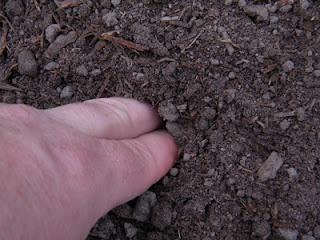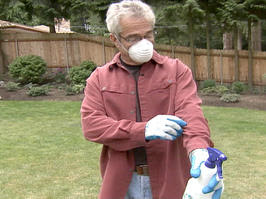Many people that are new to vegetable gardening may be wondering what are bush green beans. Bush green beans are also commonly referred to as green beans, string beans, or snap beans. There are typically two types of green beans most vegetable gardeners grow – pole beans, which grow as a climbing vine, and bush beans, which grow as a bush.
Bush green beans grow different than pole beans because bush beans grow as a bush and are generally grown in rows, similar to butter beans. Planting bush beans is really not much different than planting pole beans. They both require similar planting depths, but the spacing is a bit different
Here is how I plant bush green beans.
Preparing The Bush Green Bean Seeds
Just like pole beans, bush green beans should be soaked in a shallow container with warm water over night to speed up the germination process. The bush bean seeds will swell up as they soak up some of the water. Once the seeds have soaked overnight, drain out the water. The bush green bean seeds are now ready to be planted.
Here is how I plant bush green beans.
Bush green beans grow different than pole beans because bush beans grow as a bush and are generally grown in rows, similar to butter beans. Planting bush beans is really not much different than planting pole beans. They both require similar planting depths, but the spacing is a bit different
Here is how I plant bush green beans.
Preparing The Bush Green Bean Seeds
Just like pole beans, bush green beans should be soaked in a shallow container with warm water over night to speed up the germination process. The bush bean seeds will swell up as they soak up some of the water. Once the seeds have soaked overnight, drain out the water. The bush green bean seeds are now ready to be planted.
Here is how I plant bush green beans.
Preparing The Bush Green Bean Seeds!!!!!
Just like pole beans, bush green beans should be soaked in a shallow container with warm water over night to speed up the germination process. The bush bean seeds will swell up as they soak up some of the water. Once the seeds have soaked overnight, drain out the water. The bush green bean seeds are now ready to be planted.
You may find some seeds that have split apart or are broken. Just add these to the compost pile or discard. Don’t try to plant them because they probably will not germinate.
Preparing The Garden Row or Garden Bed For Planting !!!!
Bush green beans should be grown in fertile soil amended with good compost or organic matter and have adequate drainage. I will be growing my bush beans in a row this year. For planting in rows, bush beans need to be spaced about eight to twelve inches apart
Planting The Bush Green Bean Seeds!!!!
First, place two bush green bean seeds at eight inch intervals down the center of the entire row. Just place the seeds on top of the soil for now. Continue placing the bush bean seeds on top of the soil at eight inch intervals until you run out of seeds or run out of row; whichever comes first.
Bush bean seeds typically need to be planted at a depth of 1-1/2 inches deep. Make sure to read the seed packet for the planting depth of your particular bush beans. Here I am planting 'Early Contender' bush beans.
 Bean, Contender Bush
Bean, Contender Bush
Great bean flavor.
A heavy cropper of round-oval pods with strong,distinctive flavor. One of the best bush beans ever. Ready to harvest in 55 days.
Product Details
Days to Maturity: 55 days
Sun: Full Sun
Spread: 18-30 inches
Sowing Method: Direct Sow
Days to pick the first ripe fruit from the time the plant is transplanted in the garden.
The Hole Method of Planting Bush Green Beans!!!!
To plant the seeds, I simply take my index finger and poke a hole in the soil 1-1/2 inch deep right beside the bush green bean seeds I placed on top of the soil. By poking the hole right beside the seeds, the seeds will just fall right in the hole on their own
Once the seeds fall into the hole, use your finger to gently tap the seeds in the hole to make sure they seat properly in the soil. Avoid pushing the seeds deeper into the soil, just make sure the seeds are seated in the soil. This is to make sure the seeds come in good contact with the soil for proper growth after the seeds germinate.
Now simply cover the hole with soil and give it a light pat with the palm of your hand. Again, do not pat too hard as this is to just make sure the seed contacts the soil well.
Continue this process until all the seeds have been planted along the row.
The Push Method of Planting Bush Green Beans!!!!
Another method for planting bush beans is to simply use your index and middle fingers to push the bush beans seeds down into the soil to plant them. Simply take those two fingers and place them on top of the seeds. Gently push the seeds down into the soil until you get to the second knuckle of your fingers. This is typically about an inch and a half deep
Once you have the bush bean seeds at the proper depth, simply cover the hole with soil and gently pat with the palm of your hand. Continue this method for all of the bush bean seeds along the row until finished
Water The Bush Green Bean Seeds!!!
Once all of the bush green bean seeds are planted, give the entire row or bed a drink of water or compost tea. Thoroughly water them each day to keep them consistently moist but not soggy. The bush green bean seedlings should emerge in six to fourteen days. After the seedlings have reached about three inches high, thin them out so there is one plant every eight inches.
















































